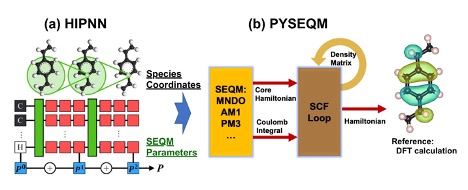Breakthrough accuracy in semi-empirical quantum chemistry via deep learning

A neural network, HIPNN (a), generates Hamiltonian parameters based on a molecular configurations. These parameters are used in a semi-empirical Hamiltonian (b) to solve the Schrodinger equation and predict atomic properties
Breakthrough accuracy in semi-empirical quantum chemistry via deep learning
Semi-empirical electronic Hamiltonians have nearly 30 years of successful history modeling chemistry processes such as photon absorption and chemical reactivity. However, they have always suffered from limited accuracy and generalizability due to the use of static parameters fit to limited datasets. New research from Los Alamos National Laboratory uses a Machine Learning model to dynamically reparametrize Semi-empirical Hamiltonians. Allowing physically interpretable model parameters to be adjusted according to the local chemical environment both significantly increases the model accuracy and enables new ways of interpreting results produced by ML models. This new paradigm of physics informed machine learning seeks to revolutionize the way machine learning models are applied to physics problems.





